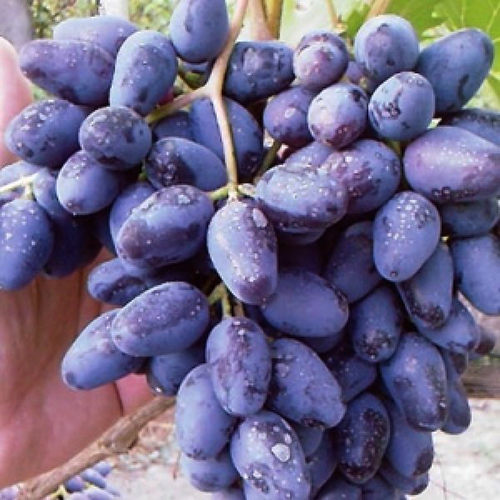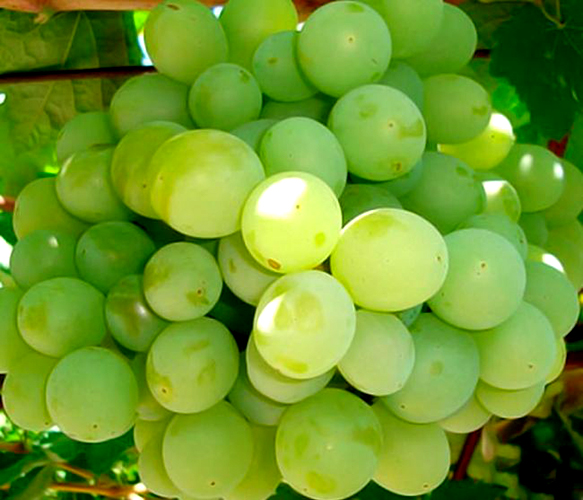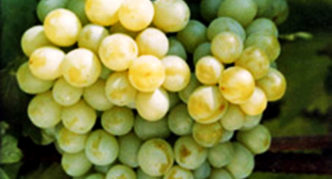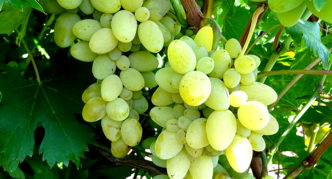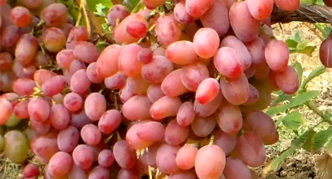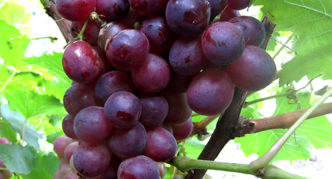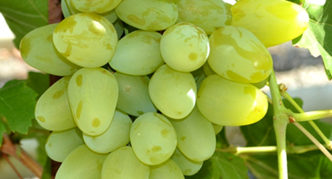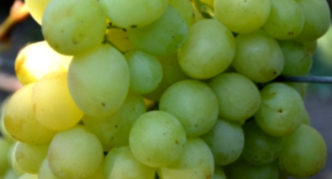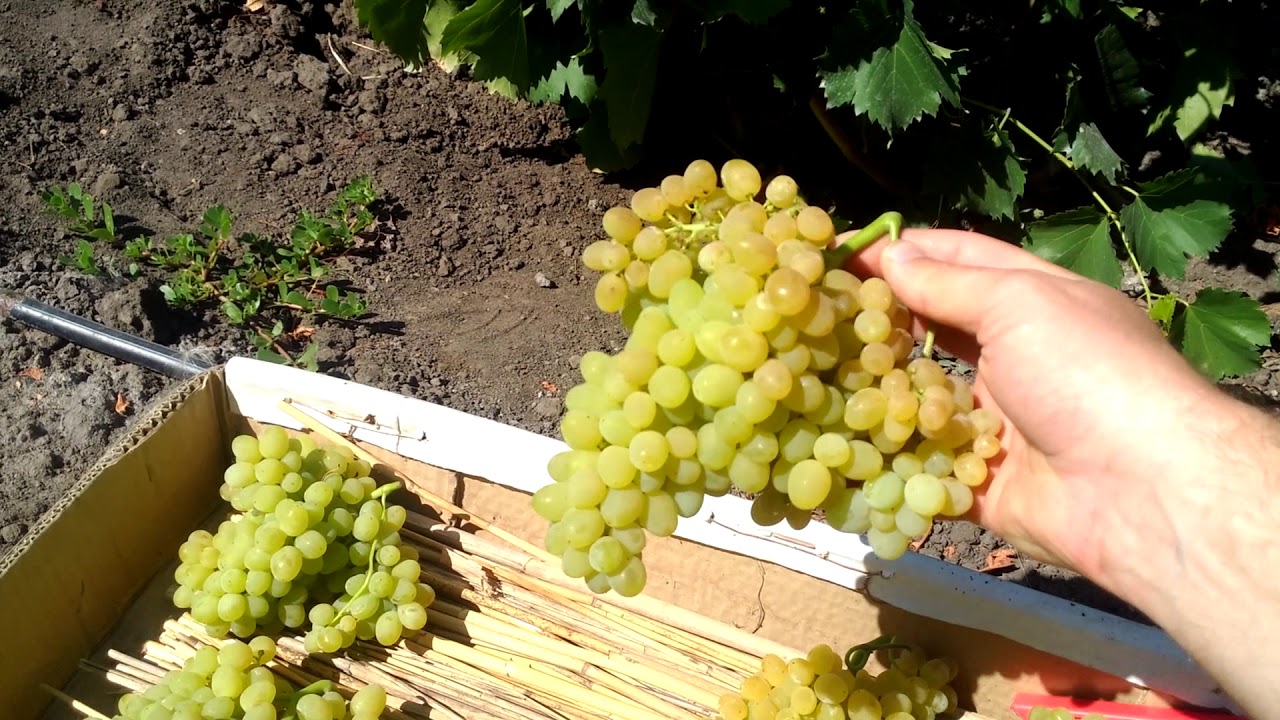Table grapes Monarch of Russian selection can be confused because of the same name with technical grapes of European selection. But these are two completely different varieties in terms of characteristics and even the color of the berries. Table grapes are yellow, and technical grapes are black.
Content
Monarch grapes of Russian selection
Monarch table grape is a vigorous plant that can withstand frosts down to –25 ° C without shelter. Its bush 2, 5-30 meters high gives many green shoots, the length of which does not exceed 140 cm. On the shoots of the current year, beautiful clusters ripening up to 600 g with large yellow berries. Each berry weighs from 15–20 g, and individual ones - up to 32 g. A light nutmeg aroma gives originality to the taste of this grape. The crop can be harvested within two to three weeks. The bunches will not lose their visual appeal, and they can also acquire a blush from direct sunlight.
The author of the table grape variety Monarch Pavlovsky Evgeny Georgievich has been growing grapes for more than thirty years. For about 20 years, he has been collaborating with the Yakov Ivanovich Potapenko All-Russian Research Institute of Viticulture and Winemaking.
Evgeny Georgievich has mastered all the methods of green grafting, which he uses both for re-grafting of adult bushes and for growing grafted seedlings. At the same time, the task of collecting information on the behavior of new hybrid forms on known and new rootstocks PP 101-14, Kober 5 BB, CO4, Ferkal is being solved. He tried himself in growing industrial batches (up to 10 thousand) of own-rooted seedlings of varieties tolerant to phylloxera.
Evgeny Georgievich's cooperation with the Institute of Viticulture began with the implementation of one-time tasks for crossing the given grape varieties. He sent the seeds of the over-pollinated plants to the institute, where they grew seedlings from them and carried out further selection work. Gradually gaining experience in breeding under the leadership of Ivan Aleksandrovich Kostrykin, E.G. Pavlovsky began to create hybrid forms of grapes on his own plot of land.
To date, he has created over 40 grape hybrids. One of them is the Monarch. This variety is obtained by the cross-pollination of American-bred Cardinal grapes with a mixture of fingers of European-Amur forms.
Then the resulting plant was crossed with grapes of the Talisman variety of the VNIIViV them. Potapenko.
The monarch retained the frost resistance of the Talisman and the taste characteristics of other ancestors.
Video: Monarch grapes
Growing grapes Monarch
Growing Monarch grapes on your site is no more difficult than any other. For him, as for any plant of this species, they choose a sunny place protected from the wind. A landing hole is prepared. Add nutrients and water abundantly after planting.This grape variety is recommended to be propagated with self-rooted seedlings in order to retain all the characteristics of this hybrid form and the flavor of the berries. Caring for the Monarch has only one difference from the generally accepted norms - in the fall, adult plants are cut only by 60% of the required volume. This is due to the peculiarity of the vegetation of this plant - during the period of pollination, a lot of ovary falls off. The bunches still get an impressive weight of 500-600 g. The author of the Monarch variety, studying this phenomenon, came to the conclusion that, due to the high growth force of the bush, the shoots of this year are fattening, that is, they receive too many nutrients and direct them to further growth. and not on the formation of fruits. In order for the ovary not to crumble, Pavlovsky E.G. recommends:
- In a young bush, leave the entire vine in the fall and do not remove anything, including double and triple shoots. In the spring, do not cut anything until the ovaries form. Only after the ovary is formed, remove excess shoots.
- In an old, well-formed bush, leave about 60 buds for fruiting in the fall. For pruning in the spring, choose not a thin, but, on the contrary, a thick vine, that is, remove those 40% of the shoots that would be pruned on grapes of other varieties in the fall. This is necessary so that the formed ovaries do not subsequently crumble.
Experienced growers still advise to thin out the foliage during the pollination period and intensively carry out green operations - debris and pinching.
What is attractive about the Monarch
Choosing grapes for your garden plot, you want to plant a plant that will not cause much trouble and will give a stable harvest. When comparing the characteristics of several grape varieties, it is easier to make a choice.
Table of characteristics of table grapes
| Variety name (dining room) | Winter hardiness | Ripening period (days) | The weight | Sugar content / acidity | Disease resistance | |
| Bunches (d) | Berries (d) | |||||
| Monarch | – 25° | 120 – 130 | 500 — 600 | 15 — 20 | 16-18% / 4-5 g / l | mildew; gray rot is high; oidium medium. |
| Pulse | – 23° | 120 – 130 | 500 – 700 | 6 – 7 | 16 - 18% / 7-8 g / l | mildew; gray rot; oidium medium. |
| Sponsor | – 22° | 120 – 130 | up to 1000 | 12–13 | 18–20% / 7–8 g / l | mildew; gray rot; oidium is low. |
| Caramol | – 22° | 120 – 130 | 300 | 4–5 | 14 - 16 %% / 5-6 g / l | mildew; gray rot; oidium medium. |
| Liang | – 22° | 120 – 130 | 200–250 | 4–5 | 12 - 14% / 6-7 g / l | relatively stable |
| Helios | – 22° | 120 – 130 | 525 | 12 – 15 | 15.1% / - 5.6 g / l | average. |
Bunches of grape varieties indicated in the table: photo
- Bunch of grapes Caramol
- Bunch of Liang grapes
- Bunch of grapes Helios
- Bunch of grapes Impulse
- Bunch of Monarch grapes
- Bunch of grapes Sponsor
Table grapes of the same ripening period are inferior to the Monarch in frost resistance and berry size, and often in disease resistance. Many growers consider the main disadvantage of the variety to be the dropping of the ovary, but if you follow the pruning rules proposed by E.G. Pavlovsky, this can be avoided by retaining all the dignity of the Monarch:
- large berries and beautiful clusters;
- fruits remain on the bush for a long time without loss of taste and external damage;
- berries do not crack during prolonged rains and do not rot;
- tolerates transportation well;
- on adult bushes, the clusters become larger;
resistance to most fungal diseases.
Winegrowers' reviews about the Monarch
The Monarch (Pavlovsky E) sapling grafted on a cober was purchased from the author in the spring of 2007. In 2008, with fan formation, it gave a signal yield of 5 bunches of about a kilogram each. A very large berry, amber in color, without peas, unlike SUPER EXTRA, the flesh is dense, with a light nutmeg. Ripe on August 20. Two bunches grew until mid-October and were eaten. The vine ripened well. GF is vigorous, resistant to mildew, powdery mildew, gray rot. It is not resistant to anthracnose.
Hello. I took my Monarch from Pavlovsky, a bush for three years. When he took it, he asked for a vaccinated one and Pavlovsky immediately offered me a vaccinated one on Ferkal, while assuring that the Monarch flies from Kober in the third and fourth year,due to these reasons, the bush is medium-sized. The form is quite stable and with three treatments no diseases were observed. Pollination is good, for example, nearby Beauty fell completely during flowering. Monarch ripens in the middle of August, a berry with a small pinkish color and light nutmeg with good sugar accumulation, a wasp even After harvesting the crop, I left two bunches for the experiment, sagged for another month, some berries began to grow razyumlivatsya, the taste only improved. Perhaps they would have sagged more, but were discovered by my son and ...
I started shedding even before flowering. I didn't expect this from him. Grafted bush, 3 years old, should have been the first normal fruiting. Some inflorescences crumbled completely and dry up. Next year I will try to fight this phenomenon, if it does not work out, I will replace the variety.
Harvesting Monarch grapes is no more difficult than any other. And the growers' complaints about the shedding of the ovary during pollination are due to the fact that they did not pay attention to the recommendations of the author of the variety for caring for this plant. And they had to make sure from their own experience that it is impossible to ignore the peculiarities of trimming this hybrid form.

